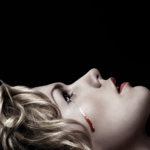There’s a reason queer people have always felt drawn to horror. Just like us, monsters exist outside the norm. Often, their nature is repressed, they are punished for their desires and feared for their difference. Today, we wanted to take a look at the myth of the vampire and the seductive, defiant figure and its history with lesbianism.
From Sheridan Le Fanu’s ‘Carmilla‘ and Jesús Franco’s ‘Vampyros Lesbos‘ to Jet Wilkinson’s ‘First Kill‘, bloodsucking women have long been linked to sapphic desire.
This fascination, dating back to the earliest Gothic novels, has survived and evolved through generations. What did the lesbian vampire represent? How has the figure transformed? And is the modern lesbian vampire a symbol of liberation, or just another way of framing lesbianism as a sin?
Monsters as Meaning Machines
Long before Bram Stoker’s Dracula, tales of vampiric creatures captivated human imagination. According to Britannica, stories of bloodthirsty monsters go as far back as ancient Greece; they were rumoured to attack sleepers and drain their life force. During medieval Europe, when plague and disease decimated populations, people whispered about corpses rising from the dead to feed on the living.
Upgrade for ad free browsing.
One figure often credited with shaping the modern vampire myth is Countess Erzsébet Báthory. Living in the late 16th and early 17th centuries, the Hungarian aristocrat allegedly murdered young women, thinking that bathing in their blood would grant her eternal youth. This cruel woman preying on girls might have been one of the inspirations for later fiction works of lesbian and lesbian-coded vampires.
In his book ‘Skin Shows: Gothic Horror and the Technology of Monsters‘, theorist Judith Halberstam reminds us that “monsters are meaning machines.”. He explains that they reflect society’s fears and forbidden desires. If medieval vampires mirrored anxiety about disease and decay, then what does the temptress and sinful gothic lesbian vampire reveal about 19th-century society?
Article continues below.
Related article: Witchy Ways: The Queer Supernatural Romance You’ll Want to Stream Right Now
The Gothic Birth of the Lesbian Vampire
In Female Gothic Histories, Diana Wallace states that gothic fiction often uses monstrous women, vampires, witches or ghosts to explore female bodies and forbidden desires. She explains that the gothic heroine is powerful but dangerous, and that danger usually demands control, through physical or metaphorical confinement. This confinement will usually be executed by men. Within this context, the lesbian-coded vampire becomes a reflection of male fears of independent women.
The first of these figures appears in Sheridan Le Fanu’s ‘Carmilla‘ (1872), published twenty-five years before Dracula. The novella follows Laura, a young woman living in isolation with her sick father in the Austrian countryside, until the mysterious Carmilla suddenly appears in their lives.
Carmilla is punished for her “unnatural” actions and monstrous cravings. Yet Laura seems to be haunted by Carmilla’s presence, even after she is gone. Today, Carmilla remains an emblematic work of Gothic fiction and has certainly shaped the figure of the lesbian vampire ever since.
On Screen: Desire, Sin, and the Monstrous Feminine
With the birth of cinema, the lesbian vampire shifted from the page to the screen. One of the earliest examples, ‘Dracula’s Daughter‘ (1936), is considered the first explicitly lesbian-coded vampire film. And by the 1960s and 1970s, she was everywhere in European erotic horror: ‘Blood and Roses‘ (1960), ‘Vampyros Lesbos‘ (1971), ‘Female Vampire‘ (1973).
These women were powerful and sensual, yet always seen through the male gaze. In these films, the lesbian vampire was fetishised and vilified; her fascinating sexual liberation was still deviant from the norm.
Related article: Best Vampire Films and TV Shows with Lesbian Representation
Feminist film theorist Barbara Creed coined the term the monstrous feminine to describe this phenomenon. In her 1993 book, she argues that horror cinema often paints the female body as monstrous, bleeding, untamable, and threatening. She explains that patriarchy’s greatest fear is a woman who cannot be contained.
Robert McRuer, in his work on crip theory, draws a parallel between queerness, disability, and monsters. He explains that monsters embody society’s fear of sick, disabled, and queer bodies. Then, what could be more terrifying than a lesbian? A woman who refuses men entirely, and embraces her “monstrous” body and desires?
Maybe that is why many queer people have transformed the figure of the vampire into something powerful. When lesbianism is so harshly punished through the symbolism of vampirism, deciding to embrace that “monstrosity” becomes an act of resistance and even liberation.
The Modern Lesbian Vampire
So, what of the twenty-first-century vampire? Now that queer people have more opportunities to live outside the shadows of sin, shame, and heteronormativity, how has the lesbian vampire evolved?
Netflix’s ‘First Kill‘ (2022), based on a short story by V. E. Schwab, follows Juliette, a young vampire who falls for her classmate Calliope, a vampire hunter.
Where the old lesbian vampire was doomed, cursed, or killed for her desires, First Kill gives us something totally different: queer teenage love. Their queerness is never questioned or justified; they just are. Both girls navigate family expectations, love, and destiny, but never shame or guilt.
It’s what happens when queer women write queer stories: the lens shifts. The result feels authentically, unapologetically queer.
Related article: Top Scary Lesbian Horror Films, Thrillers, and TV Series to Watch
Vampires Aren’t the Only Lesbian Monsters
Of course, vampires aren’t the only lesbian monsters out there. As Barbara Creed reminds us, the “monstrous feminine” takes on many forms.
Take ‘Jennifer’s Body‘ (2009). Jennifer, a possessed cheerleader, feeds on boys but shares an intimate, magnetic connection with her best friend, Needy. Jennifer, just like the former representation of the lesbian monster, is seductive and dangerous and seems to be corrupting Innocent Needy, leading her outside the bounds of heterosexuality. However, this time, the narrative shifts. The true monsters are the men who sacrificed her.
After Jennifer’s death, Needy inherits her powers and takes revenge. The “infectious” lesbian monster becomes a metaphor for liberation.
Related article: Lesbian Horror and Thriller Books
After centuries of being branded as deviant, sick, or dangerous, queer culture has reclaimed the monster. So, perhaps the lesbian vampire should still be monstrous. She should still terrify patriarchy and unsettle heteronormativity. She should embrace her monstrosity, her power.
If you want to discover books like Carmilla and many more, check out our list of Must-Read Lesbian Books.
Nonchalant x




